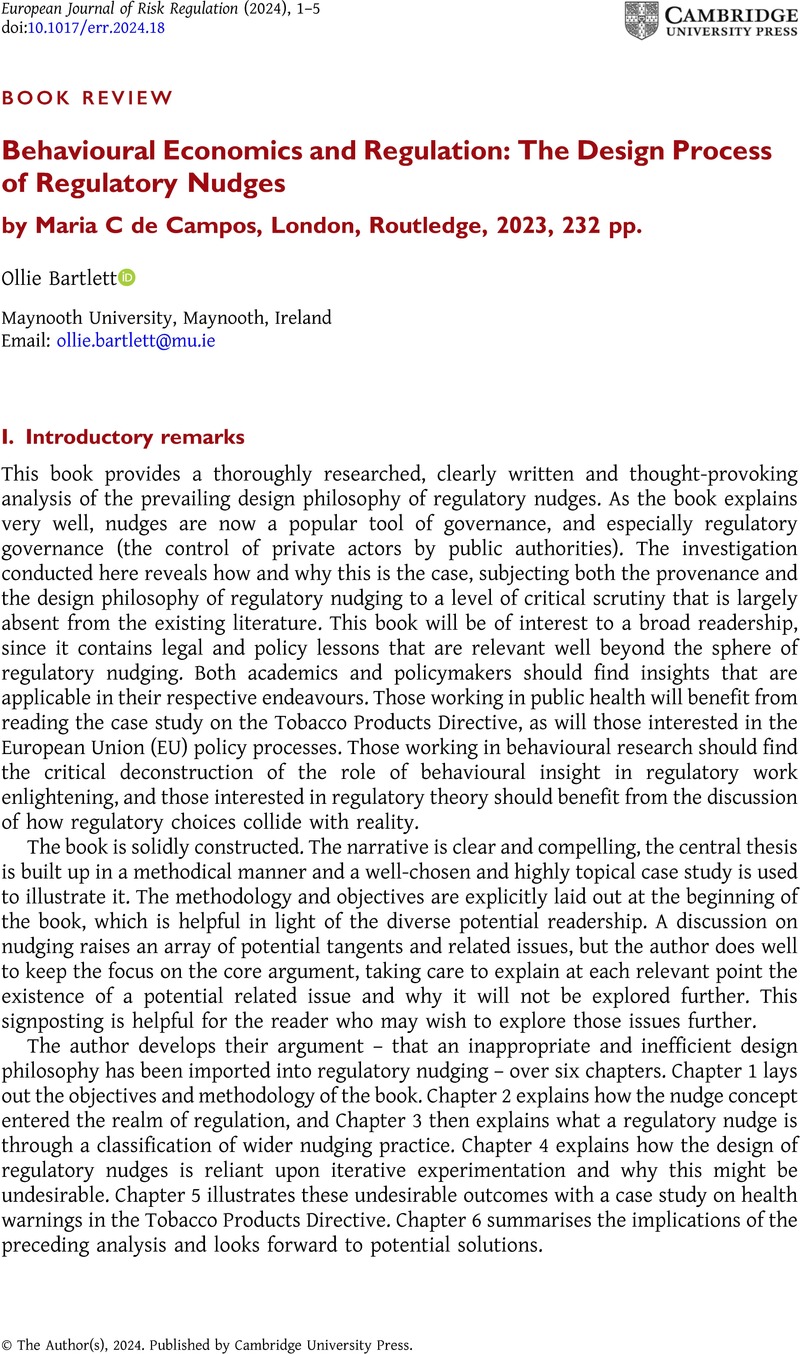No CrossRef data available.
Article contents
Behavioural Economics and Regulation: The Design Process of Regulatory Nudges by Maria C de Campos, London, Routledge, 2023, 232 pp.
Review products
Published online by Cambridge University Press: 19 April 2024
Abstract

- Type
- Book Review
- Information
- European Journal of Risk Regulation , Volume 15 , Special Issue 2: Special Issue on the Future of Food Law , June 2024 , pp. 472 - 476
- Copyright
- © The Author(s), 2024. Published by Cambridge University Press
References
1 C-376/98 Germany v Parliament and Council [2000] ECLI:EU:C:2000:544.
2 This would be a novel expansion to the literature, building upon similar types of work that explore the ways in which nudge design impacts validity; see, eg, K Grill, “Expanding the Nudge: Designing Choice Contexts and Choice Contents” (2014) 5 Rationality, Markets and Morals 139–62.
3 Eg R Baldwin, “From regulation to behaviour change: giving nudge the third degree” (2014) 77(6) Modern Law Review 831–57; A van Aaken, “Judge the Nudge: In Search of the Legal Limits of Paternalistic Nudging in the EU” in A Alemanno and A Sibony (eds), Nudging and the Law. What Can EU Law Learn from Behavioural Sciences? (Oxford, Hart 2015).
4 S Gainsbury et al, “Reducing Internet Gambling Harms Using Behavioral Science: A Stakeholder Framework” (2020) 11 Frontiers in Psychiatry 598589.
5 F Motka et al, “Who uses self-exclusion to regulate problem gambling? A systematic literature review” (2018) 7(4) Journal of Behavioral Addictions 903.
6 C Devault-Tousignant, “Qualitative Experience of Self-Exclusion Programmes: A Scoping Review” (2023) 20(5) International Journal of Environmental Research on Public Health 3987.
7 C Varallo and C Cravetto, “Alcoholic Beverages Labelling: Analysis of the Joint-self Regulatory Proposal of the Industry on Nutrition Labelling and Ingredients’ Declaration” (2018) 9(2) European Journal of Risk Regulation 329.
8 The summary of the consultation responses can be accessed at <https://ec.europa.eu/info/law/better-regulation/have-your-say/initiatives/12749-Food-labelling-revision-of-rules-on-information-provided-to-consumers/public-consultation_en>.
9 See the analysis by Movendi International at <https://movendi.ngo/news/2022/02/18/european-parliament-does-dirty-work-for-big-alcohol-votes-to-water-down-cancer-prevention-through-alcohol-policy/>.
10 The Court of Justice of the European Union has confirmed that even significant negative consequences for economic operators can be justified on the ground of protecting public health: C-547/14 Philip Morris Brands and Others [2016] ECLI:EU:C:2016:325.


